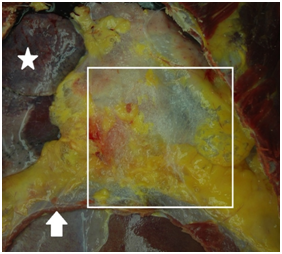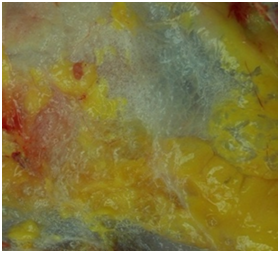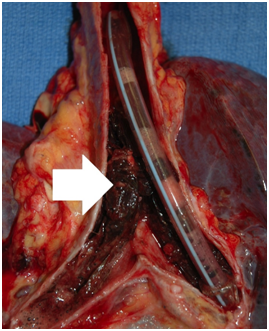eISSN: 2469-2794


Case Report Volume 3 Issue 1
Department of Pathology, Western Michigan University, USA
Correspondence: Joseph A Prahlow, MD, Department of Pathology, Western Michigan University , Homer Stryker MD, School of Medicine, 300 Portage Street, Kalamazoo, MI , 49007, USA, Tel 1-269-337-6173, Fax 1-844-337-6001
Received: August 25, 2016 | Published: November 17, 2016
Citation: Sullivan S, Prahlow JA. Asphyxiation as a consequence of “body stuffing”. Forensic Res Criminol Int J. 2016;3(1):269-271. DOI: 10.15406/frcij.2016.03.00086
“Body stuffing” is a hazardous practice in which substance dealers or abusers quickly ingest or conceal illicit substances to evade arrest or possession charges from law enforcement. This case report describes the asphyxiation death of an individual suspected of body stuffing.
Keywords: forensic pathology, autopsy, asphyxia, body stuffing, drugs, death investigation, police, cocaine, marijuana
EMS, emergency medical services; THC, tetra hydro cannabinol
The intentional intracorporeal concealment of illicit substances presents clinical, legal, and ethical challenges. “Body packing” is a phenomenon in which drug couriers conceal illicit substances in the alimentary tract for transportation across international borders or other points of possible inspection.1 In contrast, “body stuffing” is a phenomenon in which substance dealers or abusers, faced with imminent arrest, conceal illicit substances to evade arrest or possession charges from law enforcement.2 Given the quick manner of concealment and poor wrapping of packages, body stuffers are at especially increased risk of medical complications including acute poisoning, intestinal obstruction, or asphyxiation of foreign material.3 Medical personnel and law enforcement should be aware of these complications when managing individuals suspected of concealing illicit substances. Herein, our case report expands on the apparent asphyxiation and death of a male in police custody suspected of body stuffing.
A 31-year-old male in police custody passed away from apparent asphyxiation on a foreign body. Police attempted to stop the subject as he was riding a moped matching the description of a stolen moped. The subject attempted to flee police initially on his moped and then subsequently fled on foot. Police attempted one stun-gun deployment without effect. Police eventually apprehended the subject and noticed that he was having difficulty breathing.EMS was called to the scene. The paramedics arrived and attempted intubation; however, they noticed an obstruction in the oropharynx and removed a foreign body appearing to be a piece of plastic containing a "green leafy substance” (Figure 1). The paramedics again attempted intubation but noticed there was still an obstruction. The subject was transported by EMS to the emergency department where continued attempts at ventilation proved difficult. A cricothyroidotomy was eventually performed in the emergency department; however, resuscitative efforts failed and the subject expired at the hospital.

Figure 1 A photograph of the bag with a “green leafy substance” (contained within an evidence bag) removed by EMS personnel.
A complete autopsy was performed on the decedent. External examination for injury revealed a contusion on the left eyebrow, a puncture mark on the left triceps, and superficial abrasions on the right forearm, palms of the hands bilaterally, the right knee, the left knee, the left shin/ankle, and the left foot and great toe. A layer by layer anterior neck dissection revealed no injury other than the localized injury related to the cricothyroidotomy; however, there was extensive mediastinal/soft tissue emphysema (Figure 2a, 2b). Internal examination revealed a piece of plastic containing a foreign substance occluding the distal trachea and main stem bronchi bilaterally and an endotracheal tube related to the cricothyroidotomy extending past the plastic into the right main stem bronchus (Figures 3-5). The remainder of the gross internal examination was unremarkable except for focal mild aorta and coronary artery atherosclerosis. Microscopic examination revealed multifocal areas of intra-alveolar blood in the lungs (Figure 6), mild coronary artery atherosclerosis, and denuded mucosa and mild inflammation in the trachea. A postmortem blood drug screen was qualitatively positive for ethanol, THC metabolite, and cotinine, and negative for cocaine. The blood ethanol was 136 mg/dL. A postmortem urine drug screen was positive for ethanol, THC metabolite, nicotine, cotinine, cocaine, and cocaine metabolite. Substance analysis by gas chromatography-mass spectrometry demonstrated that the contents inside the plastic bag recovered at autopsy tested positive for cocaine. The substance in the bag recovered by EMS was confirmed to be marijuana. The cause of death was determined to be asphyxia due to airway obstruction by foreign body, and the manner of death was accidental.


(a) (b)
Figure 2 a) A photograph of the mediastinum following chest plate removal at autopsy, with abundant mediastinal emphysema (with in square). The star indicates the right lung. The arrow shows the anterior edge of the diaphragm. b) INSET – A closer view of the mediastinal emphysema. Note the “air bubbles” within the soft tissue.

Figure 3 An autopsy photograph showing the trachea, after opening the posterior aspect. Note the presence of an occlusive foreign body (arrow), as well as an endotracheal tube whose tip is within the right main stem bronchus.
None.
None.

©2016 Sullivan, et al. This is an open access article distributed under the terms of the, which permits unrestricted use, distribution, and build upon your work non-commercially.